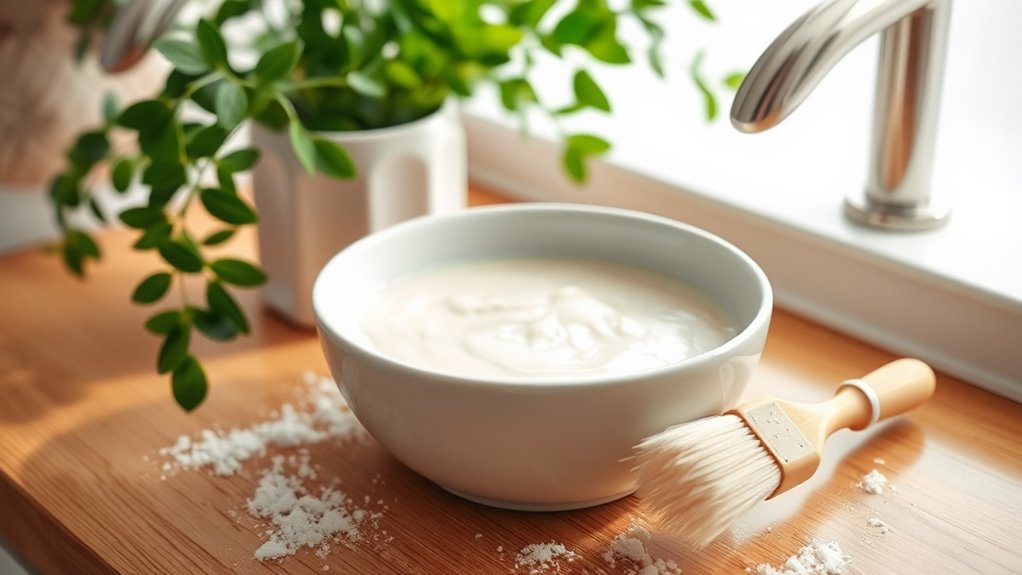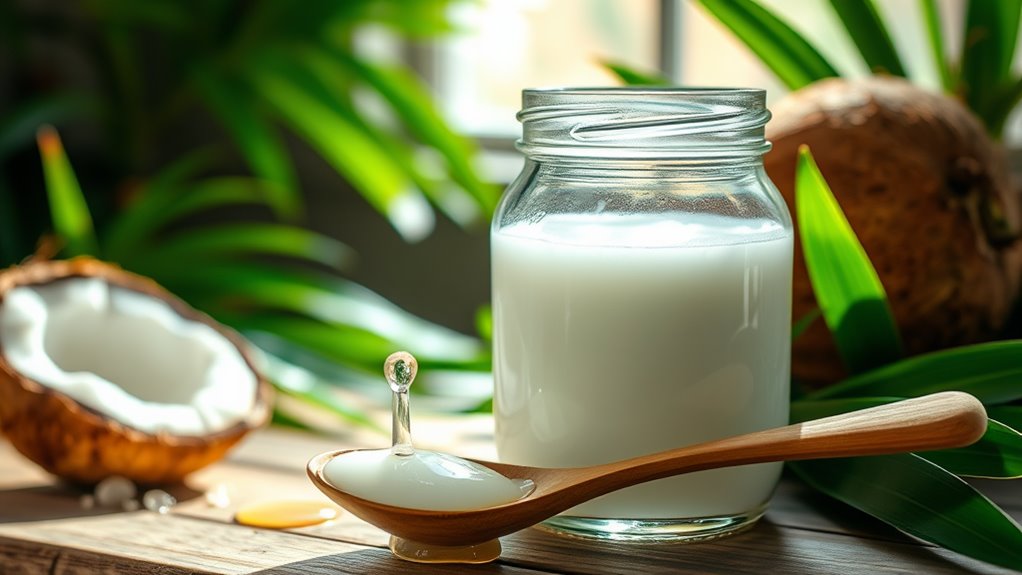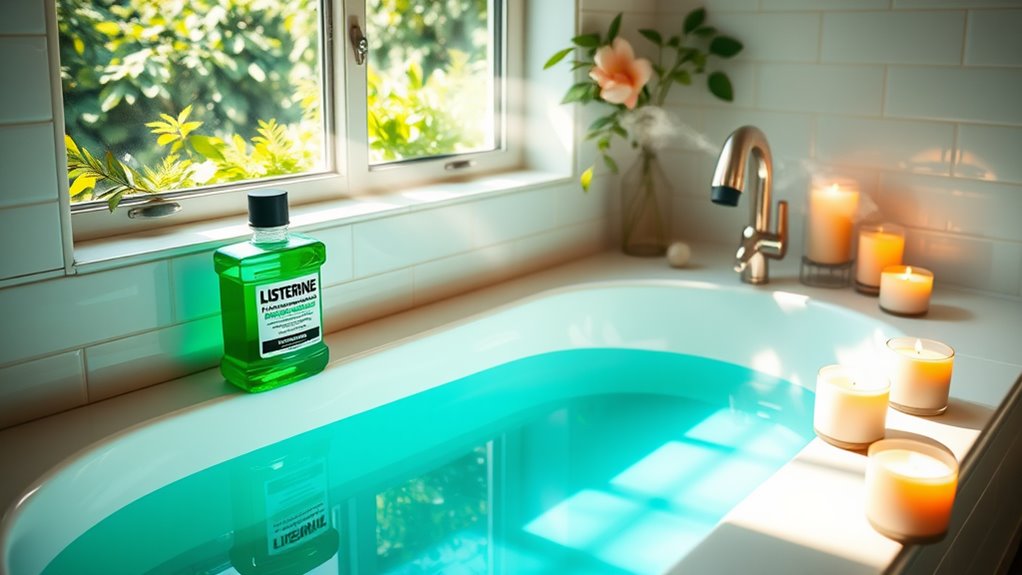Baking Soda Face Mask for Smooth, Glowing Skin
If you’re looking for an effective solution to achieve smooth, glowing skin, a baking soda face mask might be worth considering. This natural ingredient offers exfoliating properties that can help remove dead skin cells and impurities. When properly prepared and applied, it can brighten your complexion and balance your skin’s pH levels. However, understanding how to use it safely and effectively is essential to avoid irritation. Let’s explore the various aspects of this skincare treatment.
Key Takeaways
- Baking soda balances skin pH, promoting a smoother texture and reducing dullness for a glowing appearance.
- Its mild exfoliating properties remove dead skin cells, enhancing brightness and promoting cell turnover.
- Mixing baking soda with honey can provide additional hydration and soothing effects for sensitive skin.
- Limit application to once a week to prevent over-exfoliation and maintain skin’s natural barrier.
- Always conduct a patch test to ensure compatibility and avoid irritation before full application.
Benefits of Baking Soda for Skin
Baking soda, or sodium bicarbonate, offers several benefits for skin care due to its unique chemical properties.
When you use a baking soda face mask, you’re harnessing its ability to balance pH levels, effectively neutralizing acidity on your skin. This balance can help reduce irritations and maintain a healthy complexion. Additionally, baking soda possesses mild antibacterial qualities, which may aid in preventing breakouts and promoting clearer skin. Its natural alkalinity can also soothe inflammation, making it beneficial for sensitive or acne-prone skin. Moreover, it can absorb excess oil, reducing shine and breakouts for those with oily skin. Baking soda acts as a natural exfoliant, allowing for the removal of dead skin cells that can clog pores.
While a baking soda face mask can provide these advantages, it’s essential to use it sparingly to avoid potential irritation.
Ultimately, incorporating this ingredient into your routine can enhance your skin’s overall health and appearance.
How Baking Soda Exfoliates
Here’s how baking soda exfoliates effectively:
-
Physical Abrasion: The fine particles create a mild scrubbing effect, sloughing off debris.
-
pH Balance: Its alkaline nature helps dissolve excess oil, preventing clogged pores.
-
Antimicrobial Properties: It fights bacteria, reducing the risk of breakouts.
-
Moisture Retention: Exfoliation encourages moisture absorption, leaving skin hydrated.
Incorporating baking soda into your skincare routine can provide these benefits, resulting in a smoother, more refreshed complexion. Additionally, it acts as a natural exfoliant, enhancing the overall effectiveness of your skincare regimen.
Just remember to use it sparingly to avoid irritation.
Brightening Effects of Baking Soda
The brightening effects of baking soda can greatly enhance your skincare routine, helping to create a more radiant complexion. This natural ingredient works by balancing the skin’s pH levels, which can reduce dullness and promote a brighter appearance. Its mild abrasiveness gently removes dead skin cells and impurities, revealing the fresh skin underneath. Additionally, baking soda can help diminish the appearance of dark spots and uneven skin tone due to its ability to exfoliate and promote cell turnover. When incorporated into your regimen, it acts as an effective skin brightener, making your complexion look healthier. However, it’s essential to use it in moderation to avoid irritation, as overuse can disrupt your skin’s natural barrier. Its alkaline properties contribute to this balancing effect, making it a popular choice for many skincare enthusiasts. Moreover, its gentle abrasive properties make it suitable for various skin types, ensuring a safe and effective treatment.
Preparing the Baking Soda Face Mask
To prepare a baking soda face mask, you’ll need just a few simple ingredients: baking soda, water, and optional additives like honey or lemon juice.
Start by mixing the baking soda with a small amount of water until you achieve a paste-like consistency.
This straightforward process guarantees you create an effective mask that can help brighten your skin.
Ingredients Needed
While preparing a baking soda face mask, you’ll need a few essential ingredients to guarantee its effectiveness and safety for your skin. Here’s what you should gather:
-
Baking Soda: This natural exfoliant helps to remove dead skin cells and unclog pores.
-
Water: Acts as a binding agent, helping to create a paste-like consistency for application.
-
Honey: Known for its antibacterial properties, it soothes the skin and provides moisture.
-
Essential Oil (optional): Choose one like lavender or tea tree oil for added benefits and a pleasant fragrance.
These ingredients work in harmony to enhance your skin’s appearance, leaving it smooth and glowing.
Mixing Instructions
Before you begin mixing your baking soda face mask, make sure you’ve gathered all your ingredients and tools. You’ll need baking soda, water or honey, and a small mixing bowl.
Start by measuring two tablespoons of baking soda. Next, add one tablespoon of water or honey to the bowl. If you’re using water, it will create a paste-like consistency; honey will add moisturizing properties.
Mix the ingredients thoroughly until you achieve a smooth texture. Make certain there are no lumps, as these can irritate your skin.
Once mixed, your mask is ready for application. Apply it evenly to your face, avoiding the eye area, and leave it on for 10-15 minutes before rinsing off with warm water.
Safe Application Methods
Before applying a baking soda face mask, it’s essential to perform a patch test to determine your skin’s sensitivity. This will help you avoid any adverse reactions, especially on sensitive areas like around the eyes or mouth. Always be cautious and prioritize your skin’s health during the application process. Additionally, baking soda’s antibacterial properties can help combat acne-causing bacteria, making it a beneficial choice for those with breakout-prone skin. Remember, baking soda also has natural anti-inflammatory properties that can soothe irritated skin during your skincare routine.
Patch Test Importance
Conducting a patch test is essential for ensuring that your skin can tolerate a baking soda face mask without adverse reactions. This simple step helps you identify any sensitivity before applying the mask to your entire face.
Here are key benefits of performing a patch test:
- Identifies Allergies: Detects potential allergic reactions to baking soda.
- Prevents Irritation: Minimizes the risk of skin irritation or redness.
- Informs Skin Type: Helps you understand how your specific skin type reacts to new products.
- Enhances Safety: Increases overall safety when introducing new skincare ingredients.
To conduct a patch test, apply a small amount of the mixture on your inner wrist or behind your ear and wait 24 hours to observe any reactions.
Avoid Sensitive Areas
When applying a baking soda face mask, it’s crucial to avoid sensitive areas such as the eyes, mouth, and any broken skin. These regions are more susceptible to irritation due to their thinner skin and higher nerve density.
Contact with baking soda can lead to redness, discomfort, or an allergic reaction. To guarantee safe application, use a clean brush or your fingertips to apply the mask evenly, steering clear of these sensitive areas.
If you accidentally get the mask too close to your eyes or mouth, rinse immediately with cool water. After the mask treatment, monitor your skin for any adverse reactions, and discontinue use if you experience irritation.
Prioritizing safety will help you enjoy the benefits of your baking soda mask.
Tips for Best Results
To achieve the best results with a baking soda face mask, you should first verify your skin is clean and free of any makeup or impurities. This guarantees that the mask can effectively penetrate your pores and deliver its benefits.
Here are some tips to enhance your experience:
-
Patch Test: Always perform a patch test on a small area of skin to check for any adverse reactions.
-
Mix Properly: Combine baking soda with water or honey to form a smooth paste, ensuring even application.
-
Timing: Limit the mask application to 10-15 minutes to avoid potential irritation.
-
Moisturize: Follow up with a gentle moisturizer to maintain hydration after using the mask.
Potential Side Effects to Consider
While baking soda can be an effective natural remedy for skin issues, it’s essential to be aware of potential side effects. First, its alkaline nature may disrupt your skin’s natural pH, leading to dryness or irritation.
If you have sensitive skin, you might experience redness or a burning sensation. Additionally, overuse can cause the skin barrier to weaken, increasing vulnerability to environmental stressors.
It’s also important to note that baking soda can exacerbate certain skin conditions like eczema or rosacea. Always perform a patch test before applying it broadly, and limit usage to avoid adverse reactions.
Understanding these risks enables you to make informed decisions about incorporating baking soda into your skincare regimen.
Incorporating Baking Soda Into Your Skincare Routine
Incorporating baking soda into your skincare routine can be beneficial if done thoughtfully and with care. This versatile ingredient can help improve your skin’s texture and brightness when used correctly.
Here are some tips to effectively add baking soda to your regimen:
-
Start Slow: Introduce it gradually to avoid irritation, especially if you have sensitive skin.
-
Mix Well: Combine baking soda with a gentle carrier, like honey or yogurt, to enhance its soothing properties.
-
Frequency: Limit use to once a week to prevent over-exfoliation and maintain skin balance.
-
Patch Test: Always perform a patch test on a small area before applying widely to check for adverse reactions.




